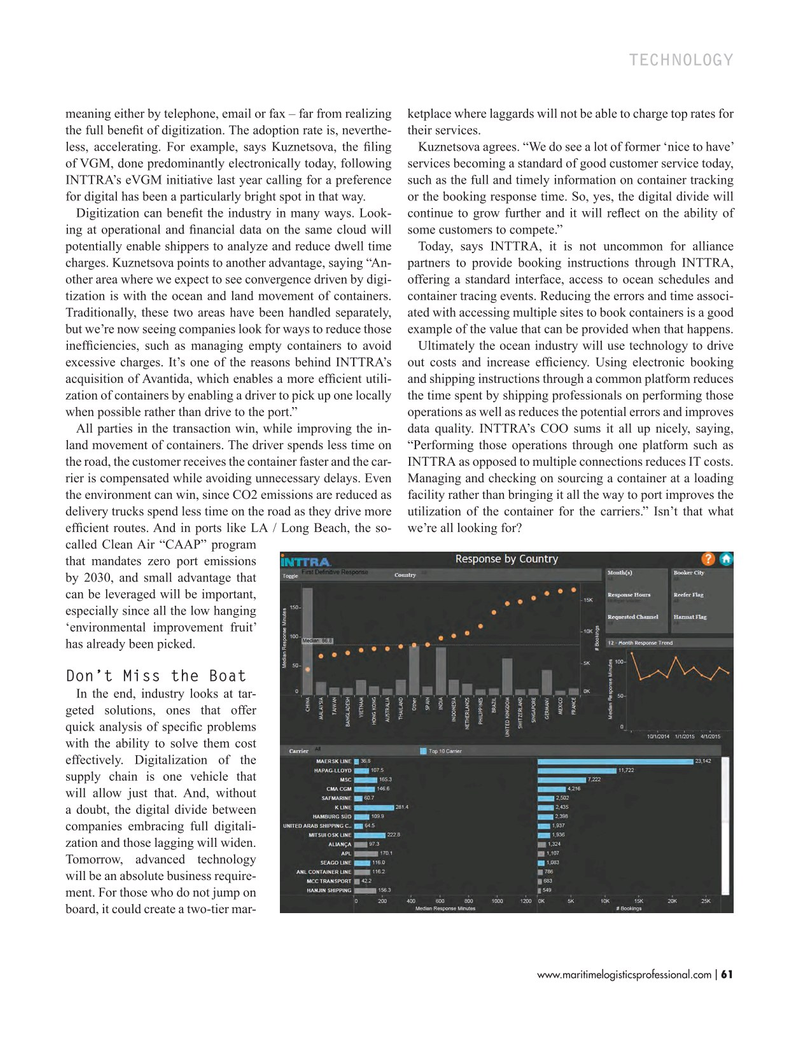
Page 3rd Cover: of Maritime Logistics Professional Magazine (Sep/Oct 2017)
CONTAINER PORTS
Read this page in Pdf, Flash or Html5 edition of Sep/Oct 2017 Maritime Logistics Professional Magazine
TECHNOLOGY meaning either by telephone, email or fax – far from realizing ketplace where laggards will not be able to charge top rates for the full beneft of digitization. The adoption rate is, neverthe- their services.
less, accelerating. For example, says Kuznetsova, the fling Kuznetsova agrees. “We do see a lot of former ‘nice to have’ of VGM, done predominantly electronically today, following services becoming a standard of good customer service today,
INTTRA’s eVGM initiative last year calling for a preference such as the full and timely information on container tracking for digital has been a particularly bright spot in that way. or the booking response time. So, yes, the digital divide will
Digitization can beneft the industry in many ways. Look- continue to grow further and it will refect on the ability of ing at operational and fnancial data on the same cloud will some customers to compete.” potentially enable shippers to analyze and reduce dwell time Today, says INTTRA, it is not uncommon for alliance charges. Kuznetsova points to another advantage, saying “An- partners to provide booking instructions through INTTRA, other area where we expect to see convergence driven by digi- offering a standard interface, access to ocean schedules and tization is with the ocean and land movement of containers. container tracing events. Reducing the errors and time associ-
Traditionally, these two areas have been handled separately, ated with accessing multiple sites to book containers is a good but we’re now seeing companies look for ways to reduce those example of the value that can be provided when that happens.
ineffciencies, such as managing empty containers to avoid Ultimately the ocean industry will use technology to drive excessive charges. It’s one of the reasons behind INTTRA’s out costs and increase effciency. Using electronic booking acquisition of Avantida, which enables a more effcient utili- and shipping instructions through a common platform reduces zation of containers by enabling a driver to pick up one locally the time spent by shipping professionals on performing those when possible rather than drive to the port.” operations as well as reduces the potential errors and improves
All parties in the transaction win, while improving the in- data quality. INTTRA’s COO sums it all up nicely, saying, land movement of containers. The driver spends less time on “Performing those operations through one platform such as the road, the customer receives the container faster and the car- INTTRA as opposed to multiple connections reduces IT costs. rier is compensated while avoiding unnecessary delays. Even Managing and checking on sourcing a container at a loading the environment can win, since CO2 emissions are reduced as facility rather than bringing it all the way to port improves the delivery trucks spend less time on the road as they drive more utilization of the container for the carriers.” Isn’t that what effcient routes. And in ports like LA / Long Beach, the so- we’re all looking for? called Clean Air “CAAP” program that mandates zero port emissions by 2030, and small advantage that can be leveraged will be important, especially since all the low hanging ‘environmental improvement fruit’ has already been picked.
Don’t Miss the Boat
In the end, industry looks at tar- geted solutions, ones that offer quick analysis of specifc problems with the ability to solve them cost effectively. Digitalization of the supply chain is one vehicle that will allow just that. And, without a doubt, the digital divide between companies embracing full digitali- zation and those lagging will widen.
Tomorrow, advanced technology will be an absolute business require- ment. For those who do not jump on board, it could create a two-tier mar- www.maritimelogisticsprofessional.com 61
I

 60
60

 4th Cover
4th Cover
